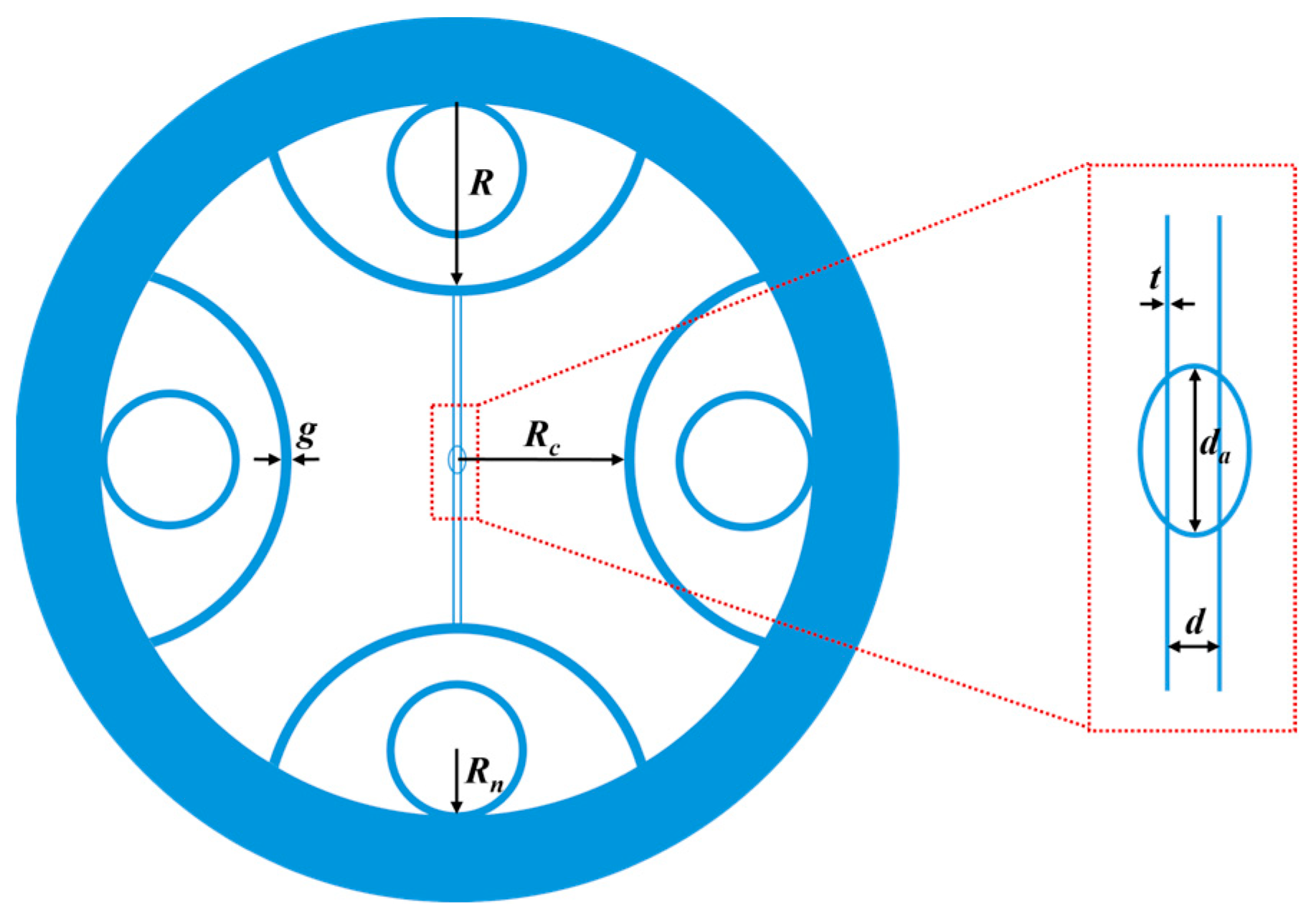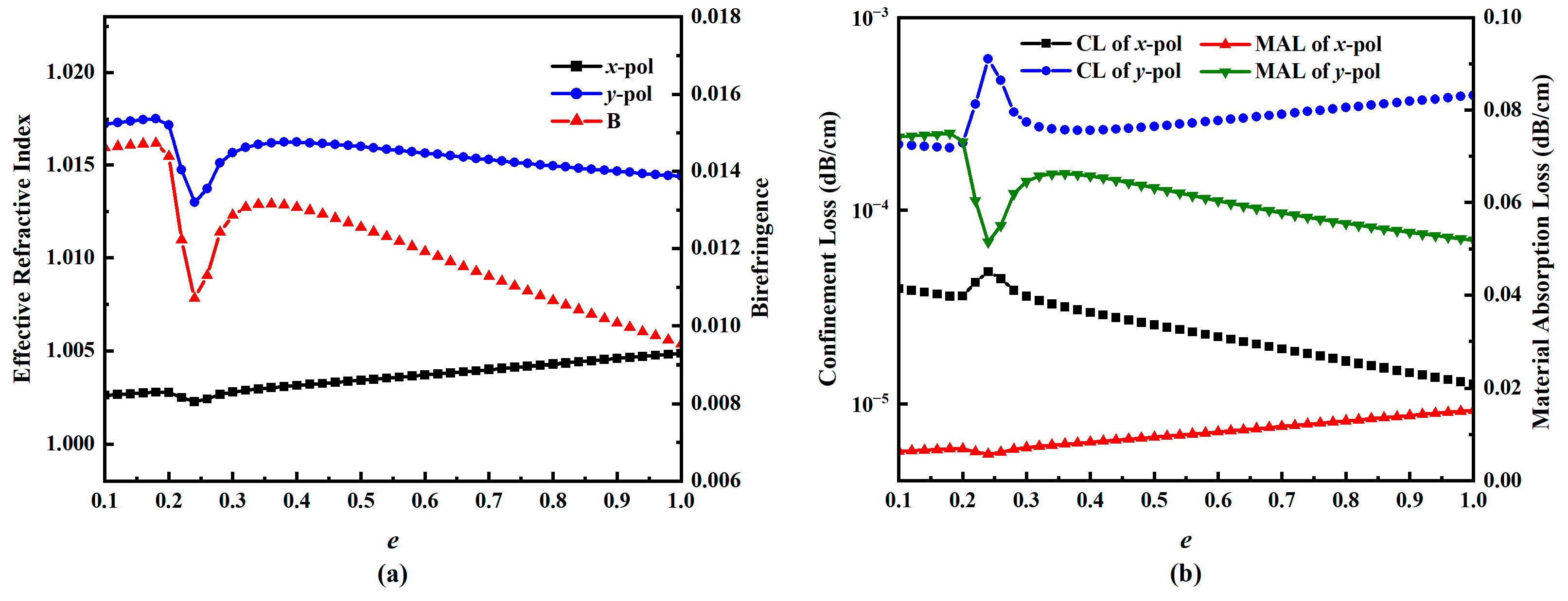Anti-Resonant Hollow-Core Fibers with High Birefringence and Low Loss for Terahertz Propagation
Abstract
:1. Introduction
2. Structure and Principle
3. Simulation Results and Discussion
4. Discussion of the Proposed AR-HCF
5. Conclusions
Author Contributions
Funding
Data Availability Statement
Conflicts of Interest
References
- Hoshina, H.; Sasaki, Y.; Hayashi, A.; Otani, C.; Kawase, K. Noninvasive mail inspection system with terahertz radiation. Appl. Spectrosc. 2009, 63, 81–86. [Google Scholar] [CrossRef]
- Pawar, A.Y.; Sonawane, D.D.; Erande, K.B.; Derle, D.V. Terahertz technology and its applications. Drug Invent. Today 2013, 5, 157–163. [Google Scholar] [CrossRef]
- Lewis, R.A. A review of terahertz sources. J. Phys. D Appl. Phys. 2014, 47, 374001. [Google Scholar] [CrossRef]
- Bergeron, A.; Marchese, L.; Savard, É.; LeNoc, L.; Bolduc, M.; Terroux, M.; Dufour, D.; Tang, D.; Châteauneuf, F.; Jerominek, H. Resolution capability comparison of infrared and terahertz imagers. In Proceedings of the Millimetre Wave and Terahertz Sensors and Technology IV, Prague, Czech Republic, 19–20 September 2011; SPIE: Bellingham, WA, USA, 2011; Volume 8188. [Google Scholar]
- Li, R.; Li, C.; Li, H.; Wu, S.; Fang, G. Study of automatic detection of concealed targets in passive terahertz images for intelligent security screening. IEEE Trans. Terahertz Sci. Technol. 2018, 9, 165–176. [Google Scholar] [CrossRef]
- Yan, Z.; Zhu, L.-G.; Meng, K.; Huang, W.; Shi, Q. THz medical imaging: From in vitro to in vivo. Trends Biotechnol. 2022, 40, 816–830. [Google Scholar] [CrossRef]
- Li, Y.; Shen, X.A.; Ewing, R.L.; Li, J. Terahertz spectroscopic material identification using approximate entropy and deep neural network. In Proceedings of the 2017 IEEE National Aerospace and Electronics Conference (NAECON), Dayton, OH, USA, 27–30 June 2017. [Google Scholar]
- Chen, Z.; Han, C.; Wu, Y.; Li, L.; Huang, C.; Zhang, Z.; Wang, G.; Tong, W. Terahertz wireless communications for 2030 and beyond: A cutting-edge frontier. IEEE Commun. Mag. 2021, 59, 66–72. [Google Scholar] [CrossRef]
- El Ghzaoui, M.; Das, S. Data transmission with terahertz communication systems. In Emerging Trends in Terahertz Solid-State Physics and Devices: Sources, Detectors, Advanced Materials, and Light-Matter Interactions; Springer: Berlin/Heidelberg, Germany, 2020; pp. 121–141. [Google Scholar]
- Liu, J.; Fan, L.; Ku, J.; Mao, L. Absorber: A novel terahertz sensor in the application of substance identification. Opt. Quantum Electron. 2016, 48, 80. [Google Scholar] [CrossRef]
- Wang, K.; Mittleman, D.M. Metal wires for terahertz wave guiding. Nature 2004, 432, 376–379. [Google Scholar] [CrossRef]
- Bingham, A.; Zhao, Y.; Grischkowsky, D. THz parallel plate photonic waveguides. Appl. Phys. Lett. 2005, 87, 051101. [Google Scholar] [CrossRef]
- Roze, M.; Ung, B.; Mazhorova, A.; Walther, M.; Skorobogatiy, M. Suspended core subwavelength fibers: Towards practical designs for low-loss terahertz guidance. Opt. Express 2011, 19, 9127–9138. [Google Scholar] [CrossRef]
- Saeedkia, D.; Safavi-Naeini, S. Modeling and analysis of a multilayer dielectric slab waveguide with applications in edge-coupled terahertz photomixer sources. J. Light. Technol. 2007, 25, 432–439. [Google Scholar] [CrossRef]
- Yakasai, I.K. Pg Emeroylariffion Abas, and Feroza Begum. Review of porous core photonic crystal fibers for terahertz waveguiding. Optik 2021, 229, 166284. [Google Scholar] [CrossRef]
- Li, L.; Lin, D.; Meng, F.; Zhao, Y.; Cui, Y.; Cao, Y.; Liu, H.; Mu, H.; Niu, Y.; He, J.; et al. Investigation on low-loss hollow-core anti-resonant terahertz fiber. Appl. Opt. 2023, 62, 5778–5785. [Google Scholar] [CrossRef]
- Hong, Y.; Bottrill, K.R.; Bradley, T.D.; Sakr, H.; Jasion, G.T.; Harrington, K.; Poletti, F.; Petropoulos, P.; Richardson, D.J. Low-Latency WDM Intensity-Modulation and Direct-Detection Transmission Over > 100 km Distances in a Hollow Core Fiber. Laser Photonics Rev. 2021, 15, 2100102. [Google Scholar] [CrossRef]
- Kühlthau, T.; Chen, B.; Kleem, G.; Graf, T.; Ahmed, M.A. Design, production, and characterization of a Large-Mode Area tubular Inhibited-Coupling Guiding Hollow-Core Fiber with low dispersion. In Proceedings of the European Conference on Lasers and Electro-Optics, Optica Publishing Group, Munich, Germany, 26–30 June 2023. [Google Scholar]
- Fu, Q.; Davidson, I.A.; Mousavi, S.M.A.; Mulvad, H.C.H.; Wheeler, N.V.; Xu, L.; Poletti, F.; Richardson, D.J. Hollow-Core Fiber: Breaking the Nonlinearity Limits of Silica Fiber in Long-Distance Green Laser Pulse Delivery. Laser Photonics Rev. 2024, 18, 2201027. [Google Scholar] [CrossRef]
- Habib, M.S.; Bang, O.; Bache, M. Low-loss single-mode hollow-core fiber with anisotropic anti-resonant elements. Opt. Express 2016, 24, 8429–8436. [Google Scholar] [CrossRef]
- Poletti, F. Nested antiresonant nodeless hollow core fiber. Opt. Express 2014, 22, 23807–23828. [Google Scholar] [CrossRef]
- Cregan, R.F.; Mangan, B.J.; Knight, J.C.; Birks, T.A.; Russell, P.S.J.; Roberts, P.J.; Allan, D.C. Single-mode photonic band gap guidance of light in air. Science 1999, 285, 1537–1539. [Google Scholar] [CrossRef]
- Chen, X.; Li, M.-J.; Venkataraman, N.; Gallagher, M.T.; Wood, W.A.; Crowley, A.M.; Carberry, J.P.; Zenteno, L.A.; Koch, K.W. Highly birefringent hollow-core photonic bandgap fiber. Opt. Express 2004, 12, 3888–3893. [Google Scholar] [CrossRef]
- Fini, J.M.; Nicholson, J.W.; Mangan, B.; Meng, L.; Windeler, R.S.; Monberg, E.M.; DeSantolo, A.; DiMarcello, F.V.; Mukasa, K. Polarization maintaining single-mode low-loss hollow-core fibres. Nat. Commun. 2014, 5, 5085. [Google Scholar] [CrossRef]
- Roberts, P.J.; Couny, F.; Sabert, H.; Mangan, B.J.; Williams, D.P.; Farr, L.; Mason, M.W.; Tomlinson, A.; A Birks, T.; Knight, J.C.; et al. Ultimate low loss of hollow-core photonic crystal fibres. Opt. Express 2005, 13, 236–244. [Google Scholar] [CrossRef]
- Fokoua, E.R.N.; Mousavi, S.M.A.; Jasion, G.T.; Richardson, D.J.; Poletti, F. Loss in hollow-core optical fibers: Mechanisms, scaling rules, and limits. Adv. Opt. Photonics 2023, 15, 1–85. [Google Scholar] [CrossRef]
- Ding, W.; Wang, Y.-Y.; Gao, S.-F.; Wang, M.-L.; Wang, P. Recent progress in low-loss hollow-core anti-resonant fibers and their applications. IEEE J. Sel. Top. Quantum Electron. 2019, 26, 1–12. [Google Scholar] [CrossRef]
- Ding, W.; Wang, Y.-Y. Hybrid transmission bands and large birefringence in hollow-core anti-resonant fibers. Opt. Express 2015, 23, 21165–21174. [Google Scholar] [CrossRef]
- Mousavi, S.A.; Sandoghchi, S.R.; Richardson, D.J.; Poletti, F. Broadband high birefringence and polarizing hollow core antiresonant fibers. Opt. Express 2016, 24, 22943–22958. [Google Scholar] [CrossRef]
- Hong, Y.F.; Gao, S.F.; Ding, W.; Zhang, X.; Jia, A.Q.; Sheng, Y.L.; Wang, P.; Wang, Y.Y. Highly Birefringent Anti-Resonant Hollow-Core Fiber with a Bi-Thickness Fourfold Semi-Tube Structure. Laser Photonics Rev. 2022, 16, 2100365. [Google Scholar] [CrossRef]
- Xue, L.; Sheng, X.; Mu, Q.; Kong, D.; Wang, Z.; Chu, P.K.; Lou, S. 3D-printed high-birefringence THz hollow-core anti-resonant fiber with an elliptical core. Opt. Express 2023, 31, 26178–26193. [Google Scholar] [CrossRef]
- Hasanuzzaman, G.; Iezekiel, S.; Markos, C.; Habib, S. Hollow-core fiber with nested anti-resonant tubes for low-loss THz guidance. Opt. Commun. 2018, 426, 477–482. [Google Scholar] [CrossRef]
- Yang, S.; Sheng, X.; Zhao, G.; Lou, S.; Guo, J. 3D printed effective single-mode terahertz antiresonant hollow core fiber. IEEE Access 2021, 9, 29599–29608. [Google Scholar] [CrossRef]
- Lu, Y.; Han, Z.; Tian, F.; Zeng, Z.; Chen, Y.; Xiu, Z.; Liu, S.; Liu, C.; Yang, X.; Zhang, J. A THz fiber polarization splitter based on anti-resonant hollow-core fiber with the asymmetric dual-suspended cores. Front. Phys. 2023, 11, 1189506. [Google Scholar] [CrossRef]
- Hasan, M.R.; Islam, M.A.; Anower, M.S.; Razzak, S.M.A. Low-loss and bend-insensitive terahertz fiber using a rhombic-shaped core. Appl. Opt. 2016, 55, 8441–8447. [Google Scholar] [CrossRef]
- Yan, S.; Lou, S.; Wang, X.; Zhao, T.; Zhang, W. High-birefringence hollow-core anti-resonant THz fiber. Opt. Quantum Electron. 2018, 50, 162. [Google Scholar] [CrossRef]
- Mollah, M.A.; Habib, M.S.; Habib, M.S. Novel hollow-core asymmetric conjoined-tube anti-resonant fiber for low-loss THz wave guidance. Osa Contin. 2020, 3, 1169–1176. [Google Scholar] [CrossRef]
- Mollah, M.A.; Rana, S.; Subbaraman, H. Polarization filter realization using low-loss hollow-core anti-resonant fiber in THz regime. Results Phys. 2020, 17, 103092. [Google Scholar] [CrossRef]
- Sun, S.; Shi, W.; Sheng, Q.; Yan, Z.; Zhang, S.; Zhang, J.; Shi, C.; Zhang, G.; Yao, J. Polarization-maintaining terahertz anti-resonant fibers based on mode couplings between core and cladding. Results Phys. 2021, 25, 104309. [Google Scholar] [CrossRef]
- Liu, Z.; Wen, J.; Zhang, L.; Zhou, Z.; Dong, Y.; Yang, T. Multiple designs with broad applicability for enhancing birefringence in low-loss terahertz HC-ARF. Results Phys. 2023, 52, 106793. [Google Scholar] [CrossRef]
- Zhao, X.; Wu, X.; Lan, X.; Luo, J.; Zhang, L.; Li, P.; Xiang, J.; Li, Z.; Cheng, Y. Adjacent nested 4-tube hollow-core anti-resonant fiber. Opt. Commun. 2022, 522, 128631. [Google Scholar] [CrossRef]
- Ventura, A.; Hayashi, J.G.; Cimek, J.; Jasion, G.; Janicek, P.; Ben Slimen, F.; White, N.; Fu, Q.; Xu, L.; Sakr, H.; et al. Extruded tellurite antiresonant hollow core fiber for Mid-IR operation. Opt. Express 2020, 28, 16542–16553. [Google Scholar] [CrossRef] [PubMed]
- Lian, Z.; Horak, P.; Feng, X.; Xiao, L.; Frampton, K.; White, N.; Tucknott, J.A.; Rutt, H.; Payne, D.N.; Stewart, W.; et al. Nanomechanical optical fiber. Opt. Express 2012, 20, 29386–29394. [Google Scholar] [CrossRef] [PubMed]








| Optical Fiber Structure | Birefringence | CL (dB/cm) | MAL (dB/cm) | Bending Radius (cm) | Bending Loss (dB/cm) | Refs |
|---|---|---|---|---|---|---|
| Elliptical tube | 10−2 | / | 0.96 | / | / | [31] |
| Double pillars | 10−1 | 2.5 × 10−3 | 1.63 | / | / | [34] |
| Circular cladding tubes | 8.7 × 10−4 | 2.1 × 10−2 | / | 15 | 2.51 × 10−2 | [36] |
| Circular cladding tubes | / | 3.4 × 10−6 | 5 × 10−4 | 45 | 10−4 | [32] |
| Circular cladding tubes | 10−4 | 1.8 × 10−3 | 1.6 × 10−3 | / | / | [38] |
| Semicircular cladding tubes | 4 × 10−4 | 1.95 × 10−2 | / | / | / | [39] |
| Semicircular and circular cladding tubes | 10−3 | 10−3 | 10−1 | 30 | 2.46 × 10−3 | [40] |
| Double pillars and elliptical tube | 1.22 × 10−2 | 8.34 × 10−6 | 7.17 × 10−3 | 12 | 1.36 × 10−3 | This paper |
Disclaimer/Publisher’s Note: The statements, opinions and data contained in all publications are solely those of the individual author(s) and contributor(s) and not of MDPI and/or the editor(s). MDPI and/or the editor(s) disclaim responsibility for any injury to people or property resulting from any ideas, methods, instructions or products referred to in the content. |
© 2024 by the authors. Licensee MDPI, Basel, Switzerland. This article is an open access article distributed under the terms and conditions of the Creative Commons Attribution (CC BY) license (https://creativecommons.org/licenses/by/4.0/).
Share and Cite
Du, Y.; Zhou, D.; Zhang, R.; Zhou, J.; Zou, H. Anti-Resonant Hollow-Core Fibers with High Birefringence and Low Loss for Terahertz Propagation. Electronics 2024, 13, 2382. https://doi.org/10.3390/electronics13122382
Du Y, Zhou D, Zhang R, Zhou J, Zou H. Anti-Resonant Hollow-Core Fibers with High Birefringence and Low Loss for Terahertz Propagation. Electronics. 2024; 13(12):2382. https://doi.org/10.3390/electronics13122382
Chicago/Turabian StyleDu, Yuhang, Dinghao Zhou, Ruizhe Zhang, Jingkai Zhou, and Hui Zou. 2024. "Anti-Resonant Hollow-Core Fibers with High Birefringence and Low Loss for Terahertz Propagation" Electronics 13, no. 12: 2382. https://doi.org/10.3390/electronics13122382





